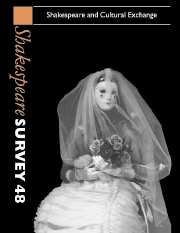Book contents
- Frontmatter
- Shakespeare Translation as Cultural Exchange
- Shakespeare, Theatre Production, and Cultural Politics
- ‘Amphitheaters in the Body’: Playing with Hands on the Shakespearian Stage
- ‘Shakespur and the Jewbill’
- Wilhelm S and Shylock
- Pilgrims of Grace: Henry IV Historicized
- Holy war in Henry V
- Hamlet and the Anxiety of Modern Japan
- Hamlet’s Last Words
- Venetian Culture and the Politics of Othello
- ‘My Music for Nothing’: Musical Negotiations in The Tempest
- The Tempest and Cultural Exchange
- Caliban and Ariel Write Back
- Shakespearian Rates of Exchange in Czechoslovakia 1945–1989
- ‘Are you a Party in this Business?’ Consolidation and Subversion in East German Shakespeare Productions
- The Martyred Knights of Georgian Shakespeariana
- Shakespeare Performances in England, 1993–1994
- Professional Shakespeare Productions in the British Isles, January – December 1993
- 1 Critical Studies
- 2 Shakespeare’s Life, Times, and Stage
- 3 Editions and Textual Studies
- Books Received
- Index
The Tempest and Cultural Exchange
Published online by Cambridge University Press: 28 March 2007
- Frontmatter
- Shakespeare Translation as Cultural Exchange
- Shakespeare, Theatre Production, and Cultural Politics
- ‘Amphitheaters in the Body’: Playing with Hands on the Shakespearian Stage
- ‘Shakespur and the Jewbill’
- Wilhelm S and Shylock
- Pilgrims of Grace: Henry IV Historicized
- Holy war in Henry V
- Hamlet and the Anxiety of Modern Japan
- Hamlet’s Last Words
- Venetian Culture and the Politics of Othello
- ‘My Music for Nothing’: Musical Negotiations in The Tempest
- The Tempest and Cultural Exchange
- Caliban and Ariel Write Back
- Shakespearian Rates of Exchange in Czechoslovakia 1945–1989
- ‘Are you a Party in this Business?’ Consolidation and Subversion in East German Shakespeare Productions
- The Martyred Knights of Georgian Shakespeariana
- Shakespeare Performances in England, 1993–1994
- Professional Shakespeare Productions in the British Isles, January – December 1993
- 1 Critical Studies
- 2 Shakespeare’s Life, Times, and Stage
- 3 Editions and Textual Studies
- Books Received
- Index
Summary
Looking at commercial exchange may prove a convenient way of approaching the problem of cultural exchange in general, for commerce is steeped in all sorts of constraints and traditions and, pragmatic though it appears, still measures desire as much as reason, and reflects an estimated balance of power between seller and buyer. The proverb ‘exchange is no robbery’ (Heywood, 1542) is significant of a conceptual impediment. No less significant is the adjectival crutch it often uses in order to reassure itself and us that ‘a fair exchange is no robbery’. Yet what is a ‘fair’ exchange? At one end of the scale, exchanging or bartering one necessity for another – so long as the need for the things exchanged is similarly pressing for both parties – may in all likelihood be accounted fair. At the other end of the scale, trading one luxury for another may be found fair as long as it suits the whims and plans of the exchanging parties. The trickster king, Richard III, exclaims ‘A horse! A horse! My kingdom for a horse’ (5.7.7). It is Shakespeare who adds the exchange suggestion. All that the source (Hall) says is that when they see that the battle is lost, the king’s party ‘brought to hym a swyfte and a lyght horse to convey hym awaie’. Are we to understand that Shakespeare’s Richard is pinning a low price on his kingdom and a high price on a horse?
- Type
- Chapter
- Information
- Shakespeare Survey , pp. 147 - 154Publisher: Cambridge University PressPrint publication year: 1996



